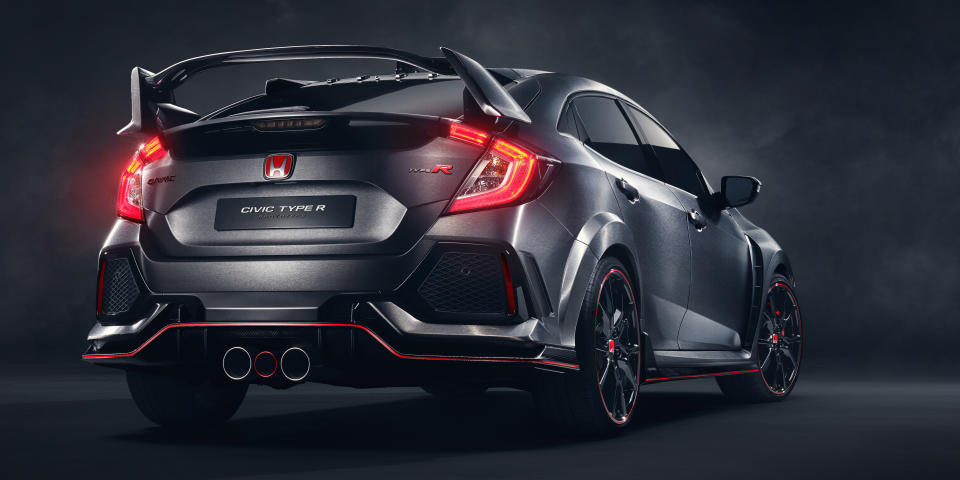All the Reasons to Get Excited About a Civic Type R CVT

Could the next Civic Type R really, as CivicX says, arrive with an optional CVT? (Update: It actually won't, Honda has confirmed, but it could have been great. Here's our reasoning. - Ed) There's an easy answer to that question, and that answer is actually two questions, and those two questions are: "So what if it does? As long as the manual transmission is available, why would you pick anything else?" Taking the clutch pedal out of one of history's all-time-great enthusiast cars would be like having Thomas Kinkade repaint the ceiling of the Sistine Chapel, or listening to an 8-track tape of the Berlin Philharmonic, or…
…Or taking the clutch pedal out of the Lamborghini Huracan, or taking the clutch pedal out of every current McLaren and every current Ferrari, or taking the clutch pedal out of the Porsche GT3. You see what I'm getting at? Clearly, there are a lot of people out there, on both the manufacturing and the purchasing side of the sports-car game, who don't want to shift for themselves. And for those people, putting a CVT in the Type R instead of a dual-clutch paddle-shifter automatic makes a ton of sense. Here's why.
To begin with, a CVT is the fastest possible way to get around a racetrack. Don't take my word for it: take the word of the Formula One rulesmakers, who banned it twenty-three years ago. So all of you hedge-fund managers and #richkidsofinstagram who rationalize your inability to drive a stick-shift by citing how much faster a DCT is around a track-take that! A CVT is even faster!

A properly configured CVT allows an engine to operate at its power peak pretty much all the time. We all understand that a four-speed transmission is usually faster around a track than a three-speed, and a five-speed is faster still, and so on. Well, a CVT is a transmission with infinite gears (within a certain range) and it's never in the wrong gear.
This is particularly important for a high-pressure, small-displacement turbo engine like the one found in the Civic Type R. A big turbo means big lag; just ask anybody who is making 600hp on a dyno with a single-pinwheel Supra. Modern cars get around that by having smaller turbochargers, but a small turbo is inefficient at high revs and large intake volumes.
As LJK Setright once wrote, the automatic transmission can address this issue because it can "be at work when the turbo is not." By radically lowering the gear, the CVT can get the engine up to speed, and up to boost, much faster. It's a great way to mask turbo lag. Trust me: if you drive a CVT and a stick-shift Type R back to back, the CVT car will feel like it's got twice as much torque. And it will also feel like it has no flywheel whatsoever, because it will never lug against too tall of a gear.
And what about fuel economy? Here's another area where a good CVT can shine. It can keep the Type R entirely "out of the turbo" on the freeway by drastically lowering the gearing. And when you need to pass another car, the transmission will immediately spin the engine up to full boost and power. It's like shifting a Corvette from seventh to third gear manually in a big hurry. Only better.

But wait, there's more. When you go to sell your CVT-equipped Type R to the next generation of drivers, many of which will have grown up with Teslas and Leafs and other electric cars, it will be an easier sell than a stick-shift or DCT car would be. That combination of CVT and high-power turbo can make a car feel almost "electric" in its ability to deliver instant torque. This will be important to drivers who have never felt a VTEC-equipped Honda soar to a 9000rpm redline. To them, a "fast car" will be one with a lot of immediately available torque.
Now, we'd be intellectually dishonest if we didn't mention the major aesthetic drawback of a CVT: the "drone" exhaust note that doesn't rise or fall with road speed. But surely there will be a program to provide that if you really want to drive inefficiently. And just as surely, most drivers will try the program a few times then leave the car in standard mode, the same way that everybody with a paddle-shifted automatic-transmission car uses the paddles for a while then forgets their existence.
Trust me. You're going to like the way you look-and sound, and haul ass-in a CVT-equipped Civic Type R. And if you don't? Well, you can always join the hundreds of thousands of drivers out there who take a clutch-pedal-equipped Honda to work every day. I'm one of them. It's a good time. You should give it a shot, before it's too late to even have the choice. But if you can't do it, then you'll be just fine leaving your Type R in "D" and letting it do its own thing. Luckily for you, I've already given you a list of excuses for doing it.
You Might Also Like

 Yahoo Finance
Yahoo Finance 